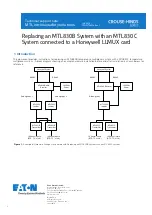
4
CALIBRATION
Ohms Zero Adjustor located at the right side of the panel,
adjusting the meter pointer to the Zero mark on the right side
of Ohm scale of the meter dial when the test leads are touched
together.
Mechanical Adjustor Screw: located right below the center of
the meter dial to set pointer to Zero mark at the left side of the
scale.
(-) Jack: Plug-in connector at the lower left on the panel for
Black, negative test lead.
(+) Jack: Plug-in connector at the lower right on the panel for
Red, positive test lead.
OPERATING INSTRUCTIONS
CAUTION
When making voltage or current measurements, develop the
habit of turning off all power to the circuit under test. Connect
the test leads at the desired points in the circuit, and then turn
on the power while taking readings. Turn off the power before
disconnecting the test leads from the circuit.
INTERNAL BATTERY CHECK
To check the battery condition, insert the black test lead into the
(-) jack. Set the range switch to the R X1 range position and
short the ends of the two sides of the test leads. If the pointer
can not be brought to the zero mark, replace the 1.5V cells or
9V cell. (See battery replacement.)
BEFORE OPERATING
1. Set the range switch to the proper position before making
any measurement.
2. Never apply more voltage or current than the rated value in
5
every position.
3. When the voltage or current to be measured it not known,
always start with the highest range.
4. If meter indication is in the lower half of the scale and falls
within the range of a lower scale, reset selector switch to the
lower range for greatest accuracy.
5. If the meter won’t work at all, check the fuse located on the
PCB. If it’s blown, replace it. (See fuse replacement.)
6. Avoid placing the meter where extreme shock or continuous
vibration is encountered and do not store in excessively hot
or damp places. Although very rugged, the meter is a
sensitive measuring device and should be handled carefully
& properly.
7. Do not check resistance, transistor, diode, LED, or
capacitance when live voltage or current input across the
circuit.
8. When the meter is not in use, keep the selector switch to the
“OFF” range position, this provides direct short across meter
movement for minimum needle bounce when transporting
meter.
9. If you should accidentally apply excessive voltage or current
on a certain range, disconnect the leads from the circuit as
quickly as possible, check instrument operation on that range
by applying peoper input. If the meter does not operate
peoperly, check fuse. If it is blown replace it. (See fuse
replacement.)
6
OPERATION PROCEDURES
DC Voltage Measurement
WARNING: WITH EXTREME CARE WHEN MAKING
MEASUREMENTS FOR HUGE VOLTAGE. DO NOT TOUCH
TERMINAL OR PROBE ENDS.
1. Set the selector switch to the appropriate DCV range to be
used.
2. Connect the BLACK test lead to the “-COM” jack and the RED
test lead to the “+” jack.
3. If you know the polarity of the circuit to be tested, connect the
black probe to the negative side.
4. If you don’t know the polarity, connect the probes to opposite
sides of the circuit and watch the pointer. If it goes to the left,
reverse the probes. The RED probe will be connected to the
positive.
5. Check the needle position and the get the reading on V.A scale.
Null DCV (Central Zero) Measurement
At these two ranges, it can automatically judge the polarity of
circuit as the pointer can move to the center line and become a
Null meter.
1. Set the selector switch to the DCV ±5V or 25V range.
2. Connect the BLACK test lead to the “-COM” jack and the RED
test lead to the Red “+” jack.
3. Set the Zero
Ω
adjustor to place the pointer exactly to the
Central Zero position if need.
4. Connect the test leads across the circuit or load under
measurement.
5. Take the readings on the Red dial Null DCV scale.
NOTE
: If the needle failed to be set at Central Zero position, the
power of 9V battery may be weak and should be replaced by
new one for normal working.
7
AC Voltage Measurement
WARNING: WITH EXTREME CARE WHEN MAKING
MEASUREMENTS FOR HUGE VOLTAGE. DO NOT TOUCH
TERMINAL OR PROBE ENDS
.
1. Set the selector switch to the appropriate ACV range to be used
and connect the test leads across the circuit or load under
measurement. (Polarity of the test probes is unimportant on
ACV test.)
2. Connect the BLACK test lead to the “-COM” jack and the RED
test lead to the“+” jack.
3. Check the needle position and the get the reading on V.A scale.
DC Current Measurement
WARNING: DO NOT APPLY VOLTAGE TO MEASURING
TERMINAL WHILE RANGE SWITCH IS IN CURRENT
POSITION. DO NOT ATTEMPT TO MEASURE AC CURRENT
.
1. Set the selector switch to the appropriate DC mA range to be
used and connect the test leads in series with the circuit or the
load under measurement. If the pointer deflects to the left,
reverse the probes.
2. Connect the BLACK test lead to the “-COM” jack and the RED
test lead to the Red “+” jack for Current at/less than 0.25A. For
large current max. 10A, move the red test lead to the Red “10A”
jack.
3. Check the needle position and the get the reading on V.A scale.
Note:
Excessive current input across mA range will blow the fuse
that must be replaced by a same fuse rating 0.5A/250V or
10A/250V. The max. testing time shall be not more than 1min.
for big current load.
























